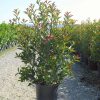North Texas boasts a distinct weather pattern characterized by hot summers, temperate winters, and sporadic dry spells. Choosing the appropriate shrubs is crucial for those tending to gardens in this area, as these plants must endure these environmental challenges while beautifying your outdoor space. Below are a few of the premier shrubs for gardens in North Texas, accompanied by advice on how to plant them and the best times to do so for their optimal growth.
Texas Sage (Leucophyllum frutescens)
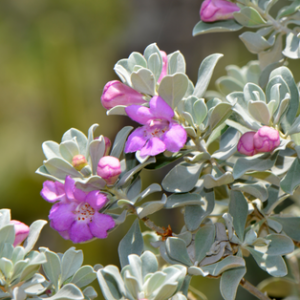 Also referred to as cenizo or purple sage, Texas sage is a resilient, drought-resistant shrub that suits the landscapes of North Texas. It features silvery-green leaves and produces beautiful purple flowers in the hotter seasons, especially following rainfall. Texas sage requires minimal care and favors soil that drains well and is sandy.
Also referred to as cenizo or purple sage, Texas sage is a resilient, drought-resistant shrub that suits the landscapes of North Texas. It features silvery-green leaves and produces beautiful purple flowers in the hotter seasons, especially following rainfall. Texas sage requires minimal care and favors soil that drains well and is sandy.
- When to Plant: Early spring or fall
- Tips for Success: Choose a location with full sun and good drainage. Avoid heavy clay soils, as Texas sage can suffer in poorly drained areas.
Holly
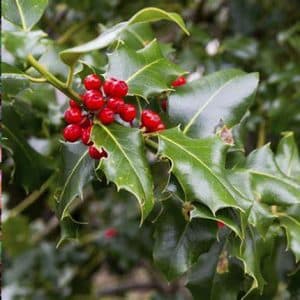 North Texas gardens benefit greatly from holly because it’s versatile and needs little upkeep. This year-round shrub features tiny, tightly packed foliage and is simple to trim into desired forms, ideal for creating hedges and edges. It bears tiny red berries during the autumn season, contributing a splash of color to your outdoor space.
North Texas gardens benefit greatly from holly because it’s versatile and needs little upkeep. This year-round shrub features tiny, tightly packed foliage and is simple to trim into desired forms, ideal for creating hedges and edges. It bears tiny red berries during the autumn season, contributing a splash of color to your outdoor space.
- When to Plant: Early spring or fall
- Tips for Success: Plant in well-drained soil with full sun to partial shade. Once established, holly is drought-tolerant, though occasional watering during dry spells is beneficial.
Wax Leaf Ligustrum (Ligustrum japonicum ‘Texanum’)
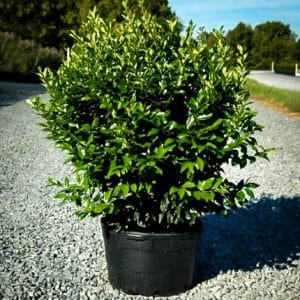 The Waxleaf Ligustrum is a favored option in North Texas because of its vibrant, shiny foliage and its ability to withstand harsh climates. This bush can be shaped into a hedge or cultivated independently. It remains green all year, offering continuous green hues, and blooms with scented white flowers during the spring season.
The Waxleaf Ligustrum is a favored option in North Texas because of its vibrant, shiny foliage and its ability to withstand harsh climates. This bush can be shaped into a hedge or cultivated independently. It remains green all year, offering continuous green hues, and blooms with scented white flowers during the spring season.
- When to Plant: Late winter to early spring
- Tips for Success: Wax leaf ligustrum prefers well-drained soil and full to partial sun. It tolerates drought and moderate shade but performs best with consistent watering, especially during prolonged dry periods.
Pittosporum (Pittosporum tobira)
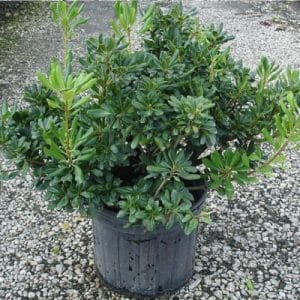 Pittosporum is an easy-to-care-for shrub featuring thick, rounded leaves and a compact growth pattern. Its appealing leaves and ability to thrive in different light environments make it a popular choice for Texas gardens. Additionally, Pittosporum blooms with scented white flowers during spring, bringing a seasonal flair.
Pittosporum is an easy-to-care-for shrub featuring thick, rounded leaves and a compact growth pattern. Its appealing leaves and ability to thrive in different light environments make it a popular choice for Texas gardens. Additionally, Pittosporum blooms with scented white flowers during spring, bringing a seasonal flair.
- When to Plant: Early spring or fall
- Tips for Success: Plant in well-drained soil with full sun to partial shade. Pittosporum is relatively low-maintenance but benefits from occasional watering during dry spells.
Nandina (Nandina domestica)
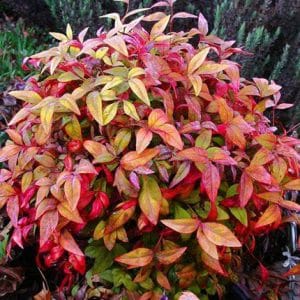 Commonly called “heavenly bamboo,” nandina is a versatile, low-maintenance shrub with year-round interest. Its delicate, lacy foliage shifts color throughout the seasons, transitioning from green to deep red and purple in the fall and winter. It also produces clusters of red berries, which can add vibrancy to your winter garden.
Commonly called “heavenly bamboo,” nandina is a versatile, low-maintenance shrub with year-round interest. Its delicate, lacy foliage shifts color throughout the seasons, transitioning from green to deep red and purple in the fall and winter. It also produces clusters of red berries, which can add vibrancy to your winter garden.
- When to Plant: Early spring or fall
- Tips for Success: Nandina can adapt to a range of soil types, including clay and sandy soils, and does well in full sun or partial shade. Regular watering during dry periods will help it stay healthy.
When to Plant Shrubs in North Texas
The ideal times to plant most shrubs in North Texas are during the early spring (February to April) and fall (September to November). Planting in spring ensures shrubs have sufficient time to develop a strong root system before the scorching summer temperatures, whereas planting in fall enables them to root during the winter, providing a solid foundation for growth in the spring. It’s best to steer clear of planting during the peak of summer, unless it’s absolutely essential, as the heat can weaken young plants, increasing their risk of drying out.
Tips for Successful Shrub Planting
-
- Soil Preparation: Test your soil before planting. Many North Texas soils are alkaline and may benefit from amendments like compost or sulfur for acid-loving plants.
- Mulching: Apply a 2-3 inch layer of mulch around your shrubs. Mulch helps retain moisture, regulate soil temperature, and prevent weeds.
- Watering: While many of these shrubs are drought-tolerant once established, they still need regular watering for the first year. Water deeply and infrequently to encourage deep root growth.
Choosing the appropriate shrubs and sowing them at the appropriate moment can significantly impact their acclimatization to the North Texas weather conditions. By opting for these robust and appealing shrubs, your garden will remain green and lively across the seasons, enhancing the aesthetic appeal and durability of your outdoor areas.
Shop all landscape shrubs.


